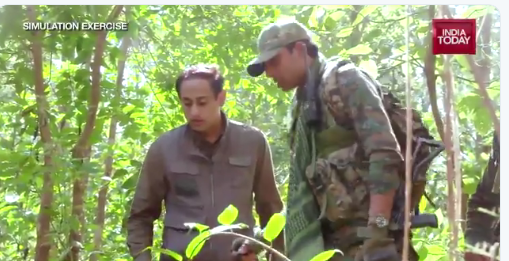Silenced Valley
The November 10 bomb blast in Delhi’s Red Fort area spawned a media blitz focusing on Kashmir, as headlines in ‘national” media screamed “terror doctors”; closely followed by the raid on the office of the Kashmir Times in Jammu. But for the media in the Valley, facing surveillance by District Information Officers, ground realities rarely come to the fore, says Urvashi Sarkar*.
Freedom of expression in Kashmir was always fraught with uncertainty. Journalists, especially those who live and work in Kashmir, now exercise even greater caution in writing and reporting, sticking to topics that would not invite scrutiny. Public criticism of authorities including the army and government, either verbally or through the written word, is rare. On social media too, self-censorship is a shield against government authorities who have frequently weeded out critics.
In April-May, 2025, India and Pakistan came very close to a full-fledged war after the killing of 23 tourists in Pahalgam, a popular tourist spot in Kashmir. I was simultaneously monitoring social media and TV news bulletins as the tensions between the two countries spiraled and threatened to snowball into something bigger with rumblings of a potential nuclear arms confrontation.
Both countries have an ever-increasing arsenal of nuclear weapons and have spent billions in acquiring a range of conventional weapons. Amidst the din of TV news anchors which did nothing to douse the fire – in the labyrinth of social media tweets where people with little more than passing knowledge vied with each other in sounding decisive and all knowing – I found little reflection on what people in Jammu and Kashmir might be thinking, much less any concern for their views.
When India agreed to a ceasefire, foreign policy analysts seated in Delhi and Washington questioned why India had conceded so quickly and ought to have pressed further into battle into Pakistan. The dust had barely settled when US President Donald Trump staked claim to having brokered peace between the two warring nations.
A few news organizations dispatched their reporters to record the plight of families terrified and displaced by shelling and drones. I went 10 days after the ceasefire to observe, take notes, and gather as much as I could in terms of conversations and insights in Srinagar and the districts of Anantnag and Kupwara.
When I arrived in Srinagar, enroute to my accommodation, I saw that shops were open but without a trace of the tourists you might expect to see at that time of the year. The famed Dal Lake lay empty – a ghost of its former self – with none of the customary tourists on their shikaras. The gardens lay empty barring a few locals. “You wouldn’t imagine how crowded it was just a few days ago, before the Pahalgam attacks. It is unbelievable to see it so empty,” a car driver told me. The attack in Pahalgam, dealt a fatal blow to Kashmir’s economy, a large part of which is derived from tourism. Food, travel and hospitality, and the arts and handicrafts industry, collapsed collectively.
“We were getting used to normalcy. The terror attacks happened in the thick of the tourist season, hitting us where it hurts the most,” the driver said. A restauranteur in Pahalgam added: “We were genuinely hurt and heartbroken for people who were brutally murdered in front of their families. But the media chose to ignore this aspect of our grief and instead claimed that we were only bothered about the loss of our livelihoods.”
Schools, offices, and establishments had resumed giving the impression of normalcy. But realities were far more complex than appeared to the outsider’s eye.
No respite
On 5 August 2025 – the sixth anniversary of the dilution of Article 370 – the Jammu and Kashmir Home Department issued an order banning 25 books for allegedly promoting secessionism and inciting violence against the public state.
The list included Arundhati Roy’s Azadi (2020), journalist Anuradha Bhasin’s A Dismantled State (2022), constitutional scholar A.G. Noorani’s The Kashmir Dispute (2013), and Australian political scientist Christopher Snedden’s Independent Kashmir (2021).
Further increasing curbs on freedom of expression, on 31 October 2025, the Department of Information and Public Relations in Kashmir wrote a letter asking District Information Officers (DIOs) to tighten vigilance on journalists by verifying their credentials. Titled, ‘Vigilance, Monitoring and Reporting of Misuse of Media Identity and Impersonation’ the directive asks DIOs to maintain and regularly update a verified list of accredited, authorised and bona fide media persons operating within the district.
Press releases, media invites, and official briefings are to be shared only with verified and recognized journalists/media outlets. DIOs have also been told to “keep a close watch” and report anyone allegedly misusing media identity or criticising officials for “private gain.” Periodic vigilance notes are also to be submitted.
On the heels of the directive, the Shopian DIO issued a stringent 10-point checklist requiring journalists to submit Aadhar and PAN information, other official identification documents, letter of appointment or affiliation with media organisations, links to social media profiles, Whatsapp Numbers, six month salary statements and academic qualification certificates. According to a statement by the People’s Union of Civil Liberties, DIOs in Kupwara, Baramulla, and Bandipora have also issued similar directives.
The PUCL statement said the directives have the cumulative effect of severely restricting access of journalists from official meets and briefings. The directive lacked transparency on how accreditation is granted and intrude on the privacy of journalists by demanding financial information. The civil liberties group also warned that the guidelines do little to curb fake news and instead criminalise legitimate reporting. It said the directive undermines the role of freelance reporters and stringers, who form the backbone of ground reporting in the Valley, by advising editors to engage only “qualified, credible and verified” correspondents.
Calling the directive the latest in a series of steps to curb press freedom since the abrogation of Article 370, PUCL cited instances of internet shutdowns, raids on newsrooms, arrests under the Unlawful Activities (Prevention) Act and detentions under the Public Safety Act. Award-winning journalists have deboarded and denied permission to travel abroad.
As curbs to freedom of expression increase and tighten, it is no surprise that ground realities in the state rarely come to the fore.
*Urvashi Sarkar is an independent journalist based in Mumbai. Views are personal and do not reflect those of any organization.
Related



Commentaries